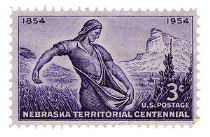Extension, Cooperative

Nebraska Agricultural Experiment Station: Historical Research Bulletins
Date of this Version
3-1940
Document Type
Article
Citation
Frolik, A.L. and Shepherd, W.O. (1940) Vegetative composition and grazing capacity of a typical area of Nebraska Sandhill range land (Research Bulletin: Bulletin of the Agricultural Experiment Station of Nebraska No. 117)
Abstract
The sandhill area of Nebraska occupies approximately 20,000 square miles of the central portion of the state. Being unadapted to cultivation, the land is for the most part still covered with native vegetation. It is utilized primarily for the production of livestock, chiefly cattle. During the period 1931 to 1938 the sandhills carried annually an average of 1,041,000 cattle, which amounted to 31 per cent of the total number in the state. The management practices used in the Nebraska sandhills have gained national recognition as a good example of range conservation in the United States. The purpose of this study was to investigate the floristic composition and the economic importance of the vegetation, as reflected by livestock carrying capacity, of the major types of grazing lands in the sandhill area of Nebraska. Accordingly, a survey of a typical area was conducted in 1937. The area selected, comprising approximately 114,000 acres in one block, was in Cherry county. It included the Valentine Migratory Waterfowl Refuge, which is about 25 miles south of Valentine. At the time of the survey the refuge had just been started and the range land included within its boundaries had been grazed prior to this time by ranchers as privately owned range.
Included in
Agriculture Commons, Agronomy and Crop Sciences Commons, Biodiversity Commons, Botany Commons, Other Animal Sciences Commons


Comments
ISSN 0097-1448